Genuine welding defects demand rejection and rework. But are all welds with any flaws considered defected?
The hard truth is that every weld has minor flaws. Even those perfectly laid TIG welds. So, a genuine welding defect needs to meet certain thresholds to be considered defective.
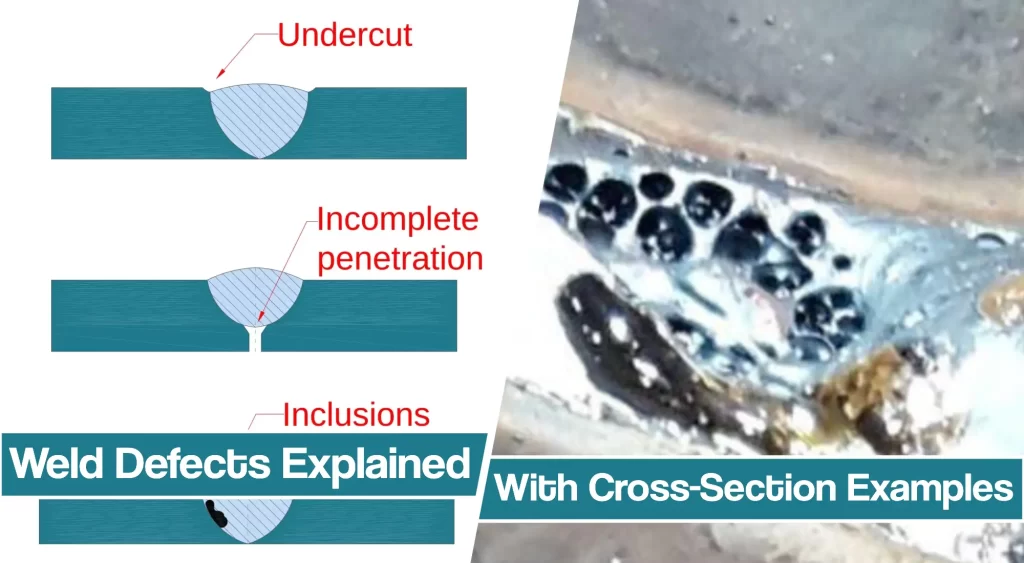
In this article, you’ll learn what is the difference between a defect and discontinuity, the most common welding defects, and how to prevent costly rework.
So, let’s start with the basics.
Difference Between a Weld Discontinuity And a Weld Defect
To put it bluntly, if you make a minor discontinuity, you don’t have to stay overtime to fix your weld joint. But, if you make welding defects.. Better read this article to up your game!
Weld discontinuities are minor flaws and interruptions in the typical weld structure. For example, a lack of uniformity in metallurgical, mechanical, and physical attributes of the weld or base metal. Every weld has such flaws. But some joints are better realized than others.
Weld defects, on the other hand, are a more serious issue. To quote the American Welding Society (AWS), “a discontinuity or discontinuities that by nature or accumulated effect render a part or product unable to meet minimum applicable acceptance standards or specifications. The term designates rejectability.”
So, if a weld has discontinuities that jeopardize the minimum standards or specifications, you should do some weld troubleshooting, and the weld is defective and needs to be repaired.
Weld defects are defined by code, and some codes are more strict than others depending on the industry and the types of loads and environment the welded part is subjected. So, a weld may be acceptable for one industry but not for others.
A single discontinuity may not meet the threshold for a weld defect. However, a cumulative effect of multiple small discontinuities can cause the welding joint to fail to meet standards. Strict welding codes may require welds to undergo certain testing to inspect the weld quality.
The Most Common Welding Defects
It’s impossible to name all welding defects, but it’s also unnecessary. The following discontinuities cause most welding defects. Study these carefully, and your welding skills will improve. The difference between a professional and a rookie is how well you can prevent defects before they happen.
Undercut
Undercut occurs when the base metal thickness is reduced adjacent to the weld toe or weld root and left unfilled. This results in a section with spots thinner than the base metal thickness. These spots are weaker and prone to failure.
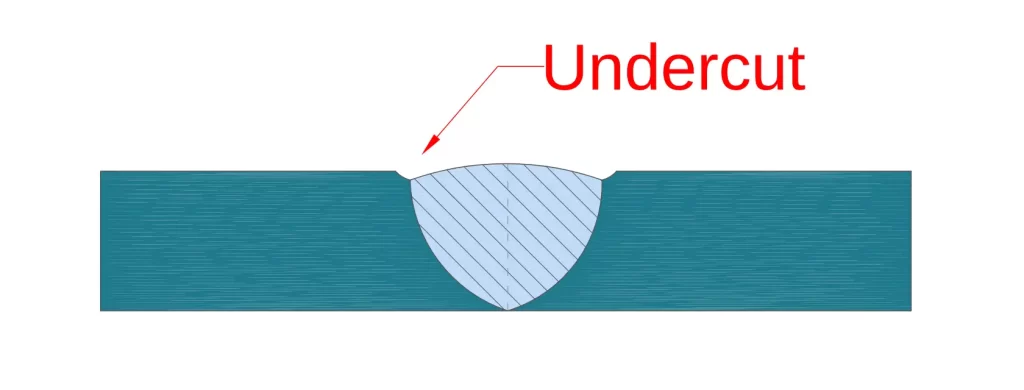
How to prevent undercutting:
- Don’t use overly high welding current or excessive welding speed
- Keep the electrode angle balanced so that you don’t lean too much on one side of the weld groove or the other. For example, welding a T joint with a fillet weld requires a roughly 45-degree angle between the electrode and the horizontal and vertical elements of the T joint
- Don’t use incorrect welding patterns
- Weld in a flat position, if possible
- Don’t use an overly long arc length
- If all else fails, try different electrode manipulation techniques to fill up the missing parts of the joint
Porosity
Porosity is caused by improper welding techniques, poor shielding gas coverage, contamination, and inadequate filler metal choice.

When dissolved gas in the molten weld pool gets trapped, it forms bubbles that are not visible while welding. Sometimes the porosity stays trapped beneath the surface, and sometimes you can see it on the surface of the weld after the weld cools down.
Nitrogen from the surrounding air can get trapped in the weld pool and cause porosity. But the more significant issue is hydrogen released when paint, oil, grease, and dirt are burnt while welding. Hydrogen often diffuses in the heat affected zone and produces underbead cracking due to porosity.
How to prevent porosity:
- Make sure you are using adequate shielding gas and that it provides sufficient coverage
- Don’t weld outside if the winds are too strong to blow off the shielding gas
- Clean the joint thoroughly
- Study the starting and stopping techniques for the welding process you are using
- Use low hydrogen electrodes
- Make sure the flux coverage of the electrode is not compromised
Cracks
Cracks are the most obvious sign that the welding defects are apparent. You can’t ignore cracks. The most dangerous aspect of cracks is that they rapidly progress, making the problem worse.
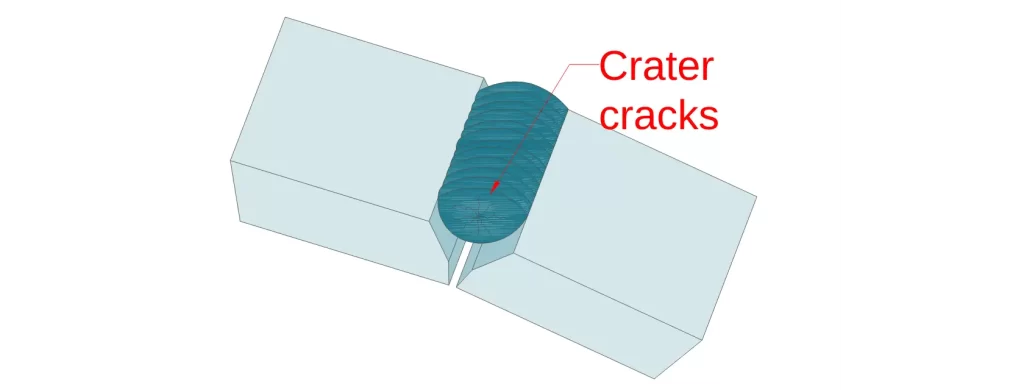
There are three types of cracking you should worry about:
- Crater or star cracks. These develop in the weld crater as the weld pool shrinks and solidifies
- Transverse cracks are found along the width of the bead
- Longitudinal cracks appear parallel to the weld’s length
How to prevent weld cracks:
- Don’t interrupt the arc too quickly at the end of the weld
- Use specialized GMAW equipment that lowers the wire feeding speed at the end of the weld
- Allow the weld to pool up at the end of the crater before extinguishing the arc
- Use correct filler metal
- Preheat the welded part, especially if welding cast iron or high strength steel
- Avoid convex-shaped bead
- Don’t use hydrogen shielding gas mixtures with ferrous metals
- Make sure that the weld joint can “work” while cooling down
Inclusions
Inclusions cause stresses to accumulate and reduce the structural integrity of the weld bead. They can be tungsten inclusions, slag inclusions, oxides, and other nonmetallic compounds. If they are trapped in the weld metal, the joint will be compromised.
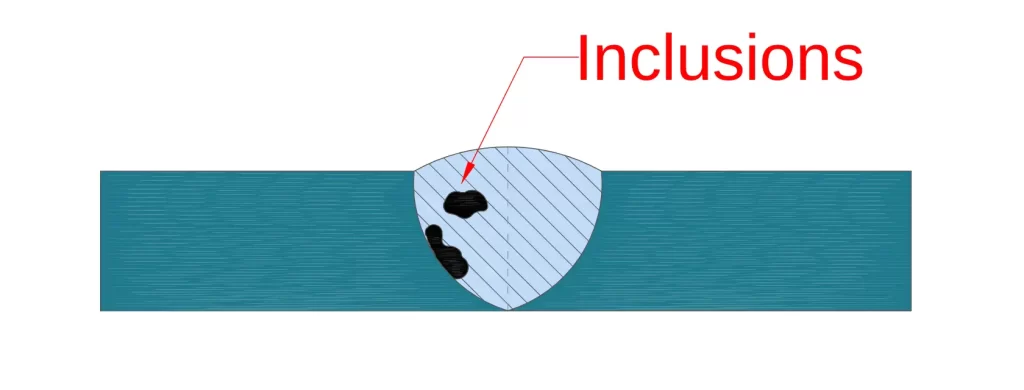
How to prevent inclusions:
- Make sure the weld joints are properly cleaned
- If making a multipass weld, create a uniform bead profile on the root weld
- Don’t touch the metal with the tungsten tip if welding with a TIG process
- Use adequate welding angle and electrode manipulation method
Inadequate Joint Penetration
Poor weld penetration occurs when the depth of penetration is not deep enough to fuse through the entire plate thickness or into the previously laid weld. This leads to the reduction of the cross-sectional thickness of the joint and serves as a source of stress concentration, which leads to welding defects.
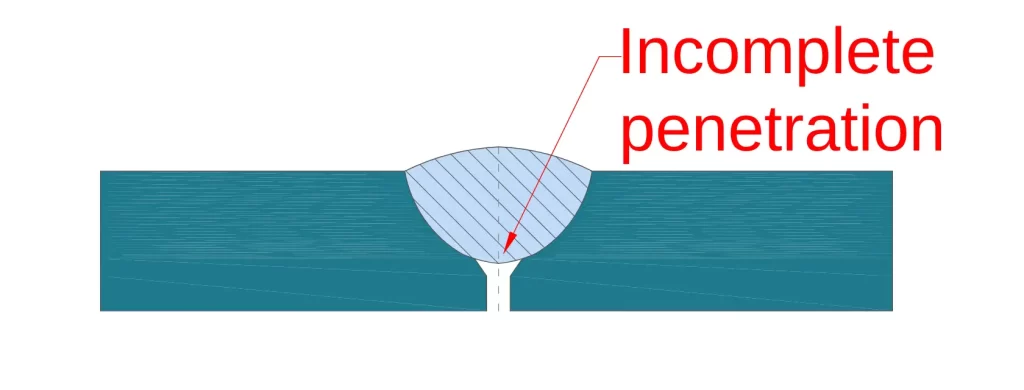
How to prevent poor joint penetration:
- Follow the correct welding technique for the process you are using
- Use enough welding current
- Preheat the metal if needed, especially metals with high thermal conductivity
- Prepare joints with evenly beveled sides
- Use back gouging if joints are accessible from both sides
Incomplete Fusion
If the weld metal is not entirely adhered to the base metal, the weld zone strength will be compromised. If there are voids, gaps, between the weld metal and the base metal, this is referred to as a lack of sidewall fusion. But, if the same occurs between the previously laid weld and the new weld metal above it, it’s called interpass cold lap.
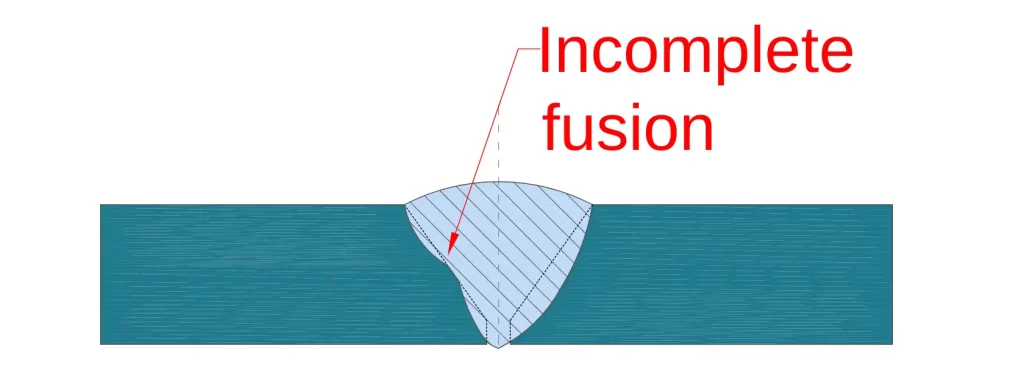
How to prevent poor fusion:
- Use the correct technique to agitate the weld pool
- Use proper torch angle
- Don’t use too fast weld speed
- Don’t use inadequate welding processes for the thickness of the metal
- Don’t use incorrect filler metal
- Remove all notches from the parent metal joint
- Clean the joint throughout
Burn Through
The opposite of incomplete penetration is when you melt the weld material and blow a hole through the base metal. Saying that this is undesirable is an understatement. If the joint has turned into molten metal, there is no weld surface and fusion.

How to prevent burn through:
- Use low heat input when welding thin gauge
- Don’t use large bevel angles
- Use high welding speed
- Use adequately sized filler metal
Arc Strikes
Arc strikes form when accidentally touching the electrode with the metal surface away from the joint. While this doesn’t damage the joint itself, it impairs the entire metal structure. These localized arc strikes cannot be removed, even if ground smooth. They will always be visible on acid etch tests, and can create localized hardness zones.
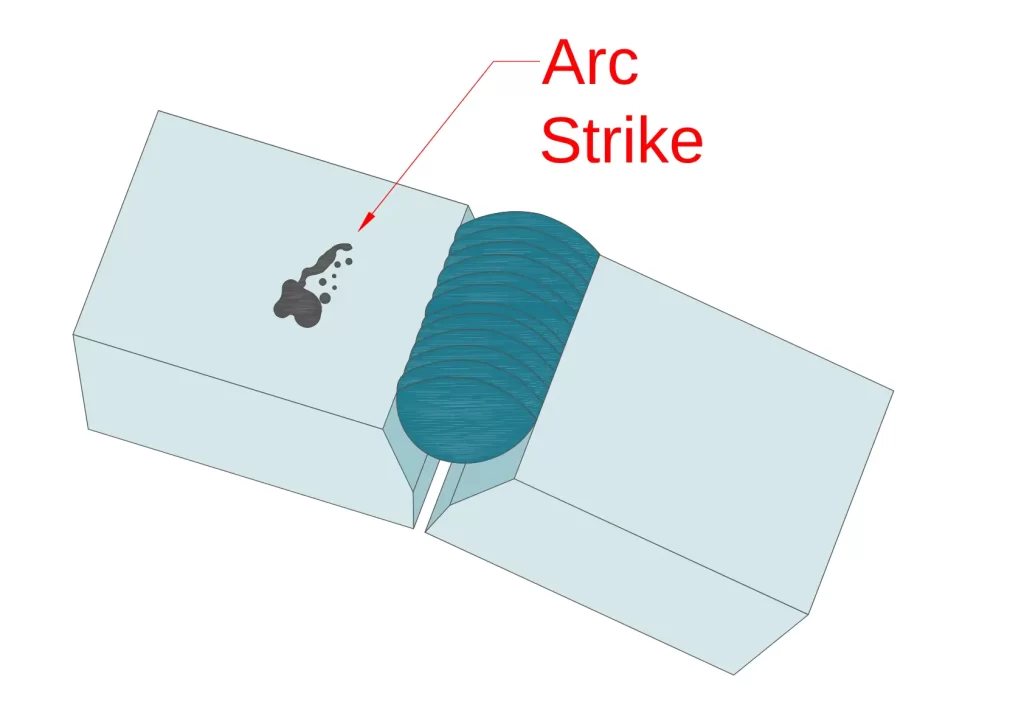
To prevent arc strikes, make sure that you keep high awareness when working with the SMAW welding process in particular. With most SMAW machines, the stick electrode is electrically hot, and as soon as the circuitry is completed, the arc strikes will happen.
Overlap
If you overfill your water cup, it spills over. Precisely the same happens if you melt too much filler metal into a groove. The weld metal flows over the surface of the base metal without properly fusing to it.
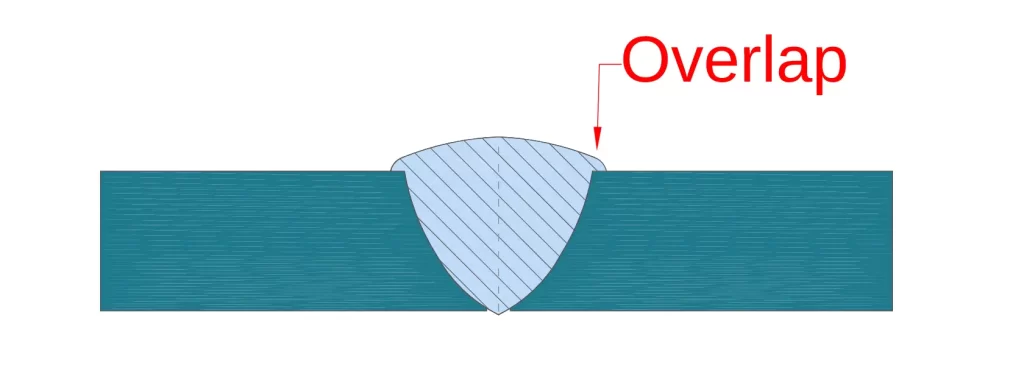
How to prevent overlap:
- Use lower filler wire speed
- Don’t misdirect electrode angle into the vertical leg
- Don’t keep the electrode vertical
- Use a higher travel speed
Underfill
In contrast to overlap. underfill occurs when there isn’t enough weld metal in the weld bead. This, of course, reduces the mechanical properties of the joint, and it’s one of the most common types of welding defects.
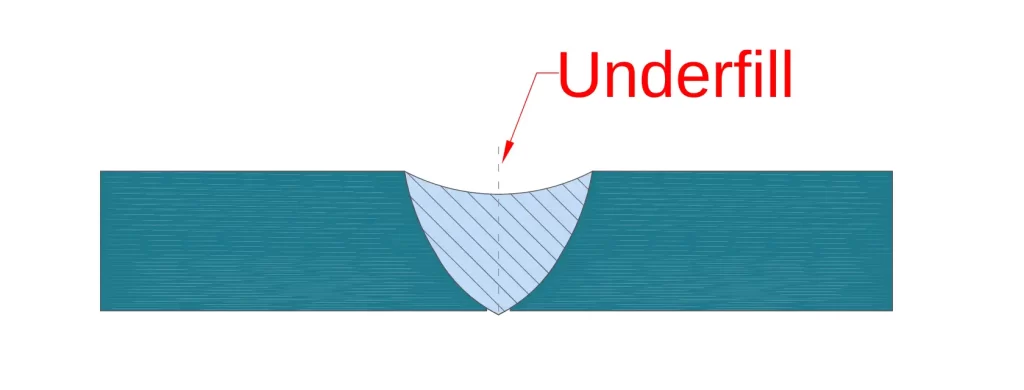
How to prevent underfill:
- Use a slower welding speed
- Increase wire feeding speed
- Make more weld passes
Excess Reinforcement
If the weld crown is too high the weld, this welding defect is referred to as excess reinforcement. The same phenomenon occurs if there is excessive penetration. In that case, the bottom of the weld has a protruding weld under the joint.
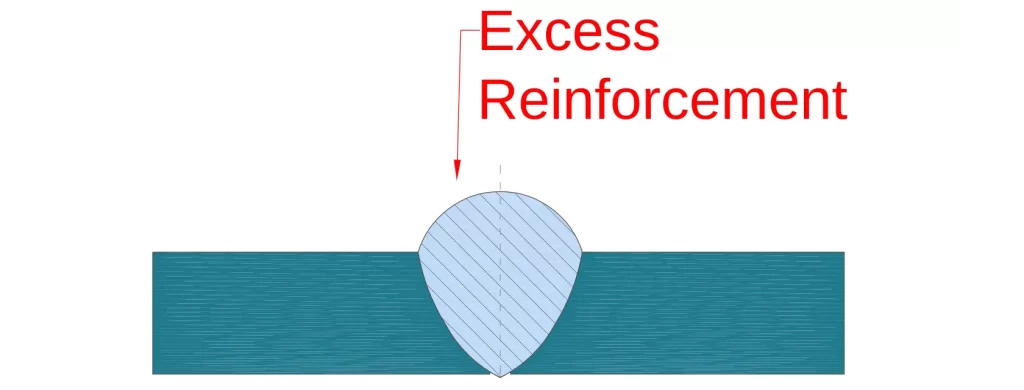
How to prevent excess reinforcement:
- Increase your welding speed to achieve a desired weld bead shape
- Keep a proper arc length
- Keep the two welded pieces evenly spaced without an excessive gap
Warpage
Warping is a nasty issue even professionals find challenging to solve. Welding thin gauge often results in uneven heat input, and as a result, warping of the metal.
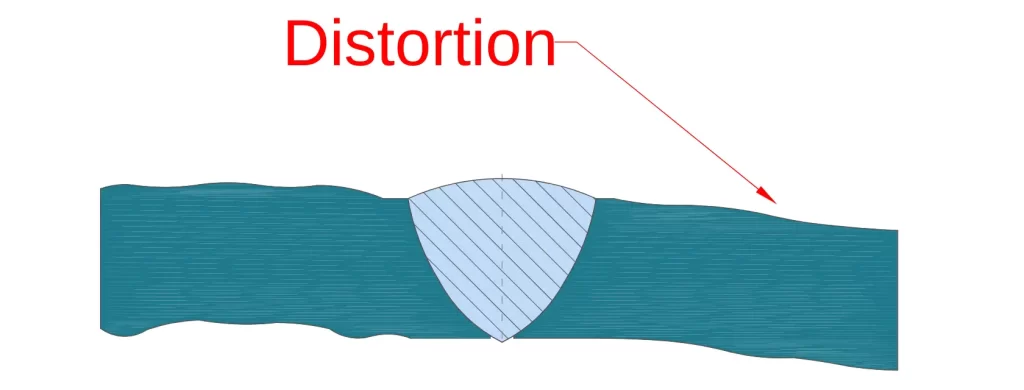
How to prevent warpage:
- Use a TIG welding process with a foot pedal for better heat input control, if possible. Additionally, if your TIG machine supports pulsed TIG welding you should apply medium to high pulses per second to prevent metal warping.
- Plan ahead your heat input. You should have a good idea of where and how to move your torch and how it will affect the weld
- Approach the joint from more sides if possible to spread heat evenly
- Reduce amperage output
- Don’t use stick welding and flux-cored processes when welding thin metal
Spatter
Spatter is rarely considered a welding defect because it doesn’t jeopardize the structural integrity of the weld metal or base metal. However, sometimes the welding procedure specification (WPS) requires particular esthetics to be achieved. In that case, it is necessary to remove any spatter.
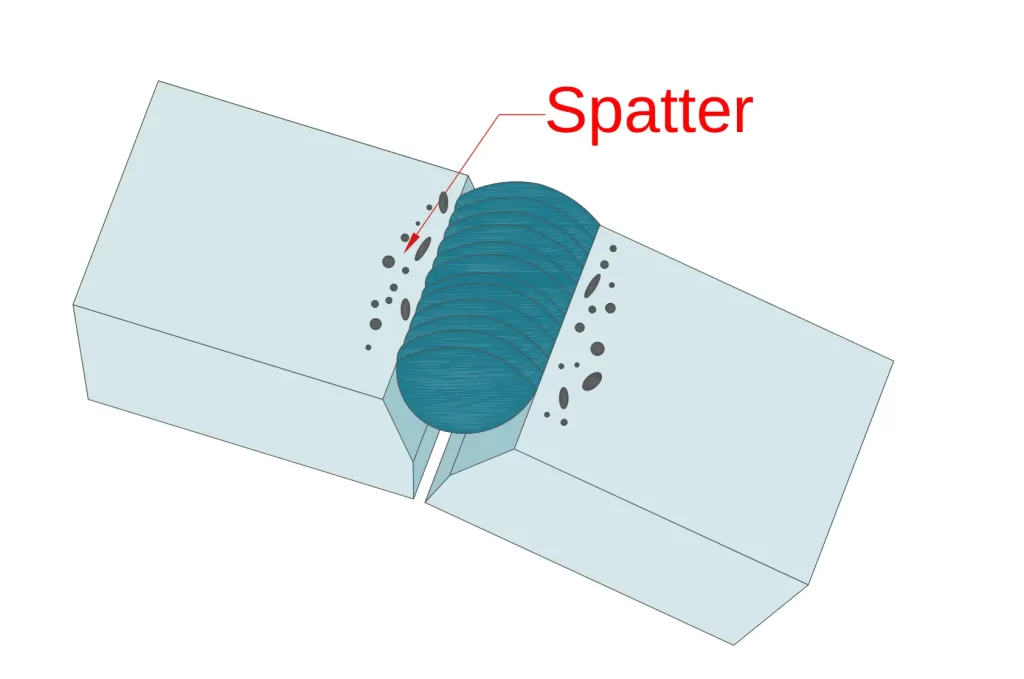
The gas metal arc welding is often the most significant contributor to spatter when welding steel. However, spatter occurs with other welding processes as well.
How to prevent spatter:
- Maintain a steady, short arc
- Reduce amperage
- Avoid flux-cored welding process if possible
- Make sure you are using a correct polarity
- Try other electrode manipulation methods
- Use adequate welding angle for the joint and welding process
Conclusion
Welding ferrous metals and non-ferrous materials often results in multiple welding discontinuities that are not considered welding defects. However, depending on the code, a higher or lower tolerance for discontinuities is applied.
This article is a short overview of causes and remedies for the most common welding defects like crater cracks, cold cracks, hot cracks, weld metal contamination, incomplete penetration, lack of fusion in the weld area, and other common weld defects.
Sources:
- Weld Defects-Their Causes and How to Correct Them by ESAB
- ISO 6520-1:2007 Welding and allied processes — Classification of geometric imperfections in metallic materials — Part 1: Fusion welding
- Practical Non-destructive Testing by Baldev Raj, T. Jayakumar, M. Thavasimuthu
- Welding: Principles and Applications by Larry F. Jeffus





